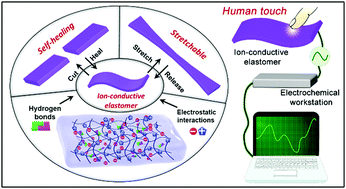Solid-state and liquid-free elastomeric ionic conductors with autonomous self-healing ability†
Abstract
Solid-state and liquid-free stretchable ionic conductors are highly desirable for stretchable electronics, because the ion-conductive hydrogels and ionogels suffer from potential solvent evaporation and leakage, respectively. Herein, we report a highly stretchable, resilient and liquid-free ion-conductive elastomer, which is further exploited as a stretchable, pressure-independent touch sensor. The liquid-free ion-conductive elastomer is reasonably designed by simultaneously incorporating highly flexible ethoxy chains and hydrogen-bonding sites into the main chains of the imidazole-based polymeric ionic liquid (PIL). The hydrogen-bond cross-linking significantly enhances the mechanical strength and resilience of the PIL-based elastomer despite maintaining a very low glass transition temperature. As a result, the solid-state and liquid-free ion-conductive elastomer possesses an ionic conductivity as high as ca. 0.131 mS cm−1 at room temperature, a satisfactory tensile strength of ca. 0.24 MPa and a high elongation-at-break of ca. 540%. Importantly, the ion-conductive elastomer exhibits an autonomous self-healing behavior at room temperature, making the cut sample easily recover its original mechanical performance and ionic conductivity. Electrical impedance-based stretchable touch sensors can be fabricated by simply incorporating the ion-conductive elastomer into the alternating current circuit. The touch sensor can accurately sense human touch regardless of being stretched or not. Because of the self-healing property, the stretchable touch sensor can easily restore its sensing performance even after break. The as-developed touch sensor shows high promise for application in human–machine interfaces of soft and stretchable electronics.



 Please wait while we load your content...
Please wait while we load your content...